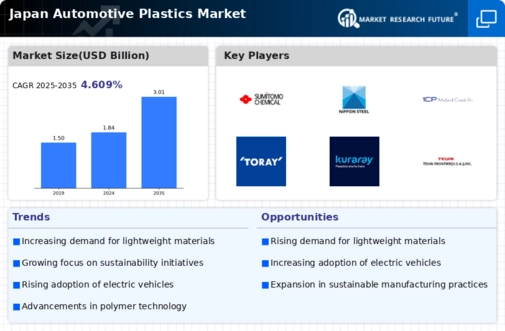The Japan Automotive Plastics Market is characterized by significant competition among various players vying for market share amid evolving consumer preferences and increasing demand for lightweight materials in automotive manufacturing. As automotive manufacturers in Japan focus on reducing overall vehicle weight to enhance fuel efficiency and meet stringent environmental regulations, the demand for advanced plastic materials has surged. Competitive insights reveal that companies are investing heavily in research and development to innovate and provide high-performance plastics tailored to specific automotive applications.
The market is driven not only by demand for traditional plastic components but also by the integration of advanced materials that offer benefits such as improved thermal stability, enhanced durability, and design flexibility. The competition is further intensified by the drive for sustainable manufacturing practices, prompting companies to explore bio-based and recyclable materials for automotive applications, thus setting the stage for innovative advancements in the sector.Sumitomo Chemical has established a formidable presence within the Japan Automotive Plastics Market, leveraging its strengths in material science and innovation capabilities.
The company is known for its advanced polymers and plastics tailored for a wide range of automotive components, including interior fittings, exterior parts, and electrical applications. With a robust portfolio of high-performance materials, Sumitomo Chemical has been able to cater to the diverse needs of automakers in Japan, positioning itself as a reliable supplier of lightweight, durable plastics. The company’s strategic focus on sustainability has also enhanced its competitiveness, enabling it to meet rising consumer expectations and regulatory requirements regarding environmental impact.
By aligning its R&D efforts with market demands, Sumitomo Chemical continues to solidify its reputation as a leader in providing innovative solutions for the automotive plastics sector.Asahi Kasei Corporation is another key player in the Japan Automotive Plastics Market, with a diverse range of products and services designed to meet the evolving needs of the automotive industry. The company specializes in producing engineering plastics, such as polyamide and polycarbonate, which are increasingly used in various automotive applications due to their excellent mechanical properties and lightweight nature.
Asahi Kasei Corporation’s commitment to innovation is reflected in its ongoing investments in research and development, resulting in high-performance materials that contribute to vehicle safety and energy efficiency. The company has also been active in pursuing strategic mergers and acquisitions to enhance its market presence and expand its product offerings. By leveraging synergies from these initiatives, Asahi Kasei Corporation aims to strengthen its competitive edge and maintain its position as a leading provider of automotive plastics within Japan.
















